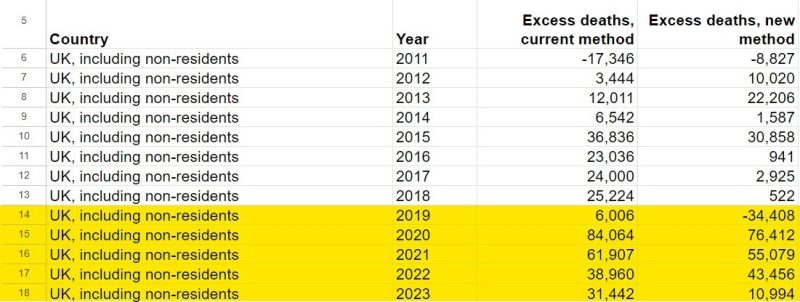Why is the ONS suddenly changing the “excess deaths” numbers?
The UK’s Office of National Statistics (ONS) announced yesterday that they are changing the way they calculate “excess deaths” across the country.
“Deaths above expected” or “excess deaths” is a statistic indicating mortality trends. Roughly speaking, it is calculated by estimating how many people die per year (based on previous years), then subtracting that number from the actual number of registered deaths.
A negative number means fewer people died than expected, a positive number means more. It’s more complicated than that, obviously, there are numerous factors that go into the modelling, but that’s essentially it.
“Excess deaths” came to public prominence during the height of the Covid “pandemic”, becoming one of those scary red statistics everyone was bandying about.
…and now the ONS is changing the way they calculate it.
Why? We don’t know, but there are few hints.
What changed?
Basically, excess deaths used to be based on a five year rolling average of registered deaths, and it’s now a rather more arcane mystery. (If you want to really dig into the method, they go into excruciating detail on their website).
Most importantly, we should note that the “old method” totally removed the “Covid” years from the modelling, while the “new method” only excludes a few months or weeks of 2020:
Individual weeks and months that were substantially affected by the immediate mortality impact of the coronavirus (COVID-19) pandemic are removed from the data when estimating expected deaths in subsequent periods, whereas the current approach involves removing data for the whole of 2020.
Note that by “current” they confusingly mean the old method prior to the new changes.
What’s the impact?
The newly released data (downloadable here) goes all the way back to 2011, re-defining 100,000s of excess deaths, but we’re just going to focus on 2019-present:

As you can see, the “new method” completely reverses the story of 2019, wiping it from 6000 excess deaths to over 34,000 deaths fewer than expected.
(While we’re looking at these numbers, it’s interesting how much of an outlier 2019 always was in terms of mortality, one wonders if there was some statistical prep-work being done to fudge deaths for the upcoming pandemic year.)
In the post-pandemic years (2021-23), by adding some of 2020 back into the modelling mix they have increased the number of expected deaths, and therefore greatly reduced excess deaths.
The end result is that, from 2020 onwards, excess mortality has been cut by ~15%. Over 30,000 “excess deaths” have been wiped off the records, over 20,000 from 2023 alone, and the vast majority since the vaccine rollout.
What was the point?
That’s a good question, we don’t know enough to form a solid conclusion yet – and I haven’t really dived into the numbers or methods to see if there’s any chicanery going on.
But we do know that statistics are a tool for opinion control and narrative management, and when they adjust official measures like this it can be an early warning sign. And by switching from a simple 5-year average to a highly complex multi-faceted model they have given themselves room to maneuver and manipulate the data in general.
It should be noted that the “new method” massively reduced excess mortality in 2019, but barely touched it in 2020, meaning the “pandemic” looks more dramatic.
It’s also possible that they are attempting to stall the appearance of Covid “vaccine” harms by re-jigging the number of excess deaths downwards. Effectively hiding potential vaccine-related deaths by re-labelling them “expected”.
The third option is that it’s laying groundwork for a future event, “the next pandemic” or something similar. By reducing the excess deaths now they can make room to exaggerate excess deaths in the future.
It could be some combination of any or all of these, it could be something we haven’t thought of yet, or it could be nothing at all.
We’ll just have to wait and see.
SUPPORT OFFGUARDIAN
If you enjoy OffG's content, please help us make our monthly fund-raising goal and keep the site alive.
For other ways to donate, including direct-transfer bank details click HERE.



